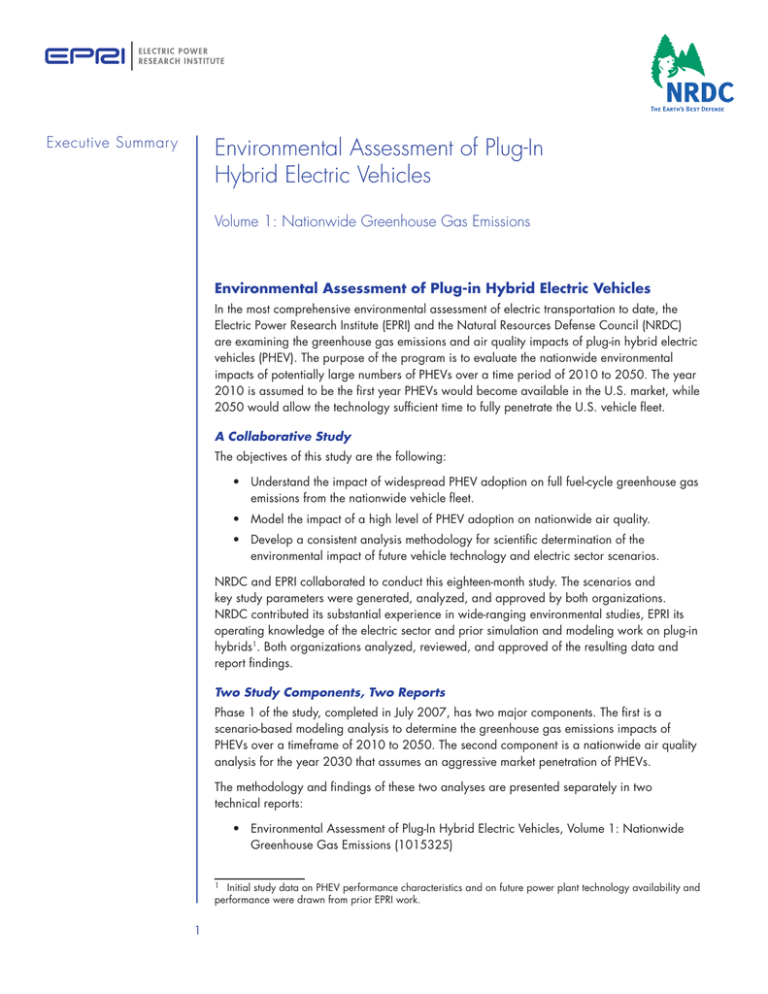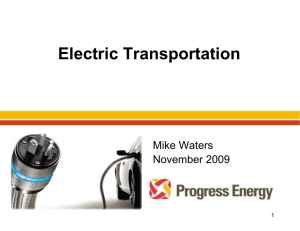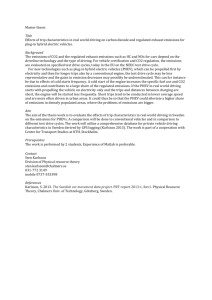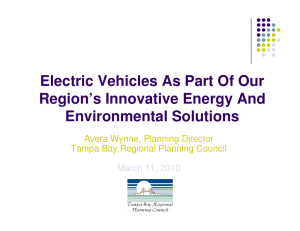
Executive Summary
Environmental Assessment of Plug-In
Hybrid Electric Vehicles
Volume 1: Nationwide Greenhouse Gas Emissions
Environmental Assessment of Plug-in Hybrid Electric Vehicles
In the most comprehensive environmental assessment of electric transportation to date, the
Electric Power Research Institute (EPRI) and the Natural Resources Defense Council (NRDC)
are examining the greenhouse gas emissions and air quality impacts of plug-in hybrid electric
vehicles (PHEV). The purpose of the program is to evaluate the nationwide environmental
impacts of potentially large numbers of PHEVs over a time period of 2010 to 2050. The year
2010 is assumed to be the first year PHEVs would become available in the U.S. market, while
2050 would allow the technology sufficient time to fully penetrate the U.S. vehicle fleet.
A Collaborative Study
The objectives of this study are the following:
• Understand the impact of widespread PHEV adoption on full fuel-cycle greenhouse gas
emissions from the nationwide vehicle fleet.
• Model the impact of a high level of PHEV adoption on nationwide air quality.
• Develop a consistent analysis methodology for scientific determination of the
environmental impact of future vehicle technology and electric sector scenarios.
NRDC and EPRI collaborated to conduct this eighteen-month study. The scenarios and
key study parameters were generated, analyzed, and approved by both organizations.
NRDC contributed its substantial experience in wide-ranging environmental studies, EPRI its
operating knowledge of the electric sector and prior simulation and modeling work on plug-in
hybrids. Both organizations analyzed, reviewed, and approved of the resulting data and
report findings.
Two Study Components, Two Reports
Phase 1 of the study, completed in July 2007, has two major components. The first is a
scenario-based modeling analysis to determine the greenhouse gas emissions impacts of
PHEVs over a timeframe of 2010 to 2050. The second component is a nationwide air quality
analysis for the year 2030 that assumes an aggressive market penetration of PHEVs.
The methodology and findings of these two analyses are presented separately in two
technical reports:
• Environmental Assessment of Plug-In Hybrid Electric Vehicles, Volume 1: Nationwide
Greenhouse Gas Emissions (1015325)
Initial study data on PHEV performance characteristics and on future power plant technology availability and
performance were drawn from prior EPRI work.
EPRI Executive Summary: Environmental Assessment of Plug-In Hybrid Electric Vehicles
• Environmental Assessment of Plug-In Hybrid Electric Vehicles, Volume 2: United States
Air Quality Analysis Based on AEO-2006 Assumptions for 2030 (1015326)
PHEV Impact on Nationwide Greenhouse Gas Emissions
Overview of Study and Results
This report describes the first detailed, nationwide analysis of greenhouse gas (GHG) impacts
of plug-in hybrid electric vehicles. The “well-to-wheels” analysis accounted for emissions from
the generation of electricity to charge PHEV batteries and from the production, distribution
and consumption of gasoline and diesel motor fuels.
Researchers used detailed models of the U.S. electric and transportation sectors and created
a series of scenarios to examine assumed changes in both sectors over the 2010 to 2050
timeframe of the study.
• Three scenarios represent high, medium, and low levels of both CO2 and total GHG
emissions intensity for the electric sector as determined by the mix of generating
technologies and other factors.
• Three scenarios represent high, medium, and low penetration of PHEVs in the 2010 to
2050 timeframe.
From these two sets of scenarios emerge nine different outcomes spanning the potential longterm GHG emissions impacts of PHEVs, as shown in the following table.
Annual greenhouse gas emissions reductions from PHEVs in the year 2050.
2050 Annual GHG Reduction
(million metric tons)
PHEV Fleet
Penetration
Electric Sector CO2 Intensity
High
Medium
Low
Low
163
177
193
Medium
394
468
478
High
474
517
612
Researchers drew the following conclusions from the modeling exercises:
• Annual and cumulative GHG emissions are reduced significantly across each of the
nine scenario combinations.
• Annual GHG emissions reductions were significant in every scenario combination of
the study, reaching a maximum reduction of 612 million metric tons in 2050 (High
PHEV fleet penetration, Low electric sector CO2 intensity case).
• Cumulative GHG emissions reductions from 2010 to 2050 can range from 3.4 to
10.3 billion metric tons.
• Each region of the country will yield reductions in GHG emissions.
More detailed results are presented below and in Chapter 5 of this report.
CO2 is the dominant greenhouse gas resulting from operation of natural gas and coal-fired power plants.
Full fuel cycle GHG emissions include N2O and CH4, primarily from upstream processes related to the production and transport of the fuel source.
EPRI Executive Summary: Environmental Assessment of Plug-In Hybrid Electric Vehicles
Study Methodology
The project team developed detailed and comprehensive models of the U.S. electric and
transportation sectors that simulated the evolution of both sectors over the 2010 to 2050
study timeframe. The researchers also developed a series of scenarios to assess the impact
of PHEVs over a range of different possible futures depending on the evolution of the energy
and transportation sectors.
Electric Sector Model
To determine the GHG emissions from the electricity generated to charge PHEV batteries,
EPRI developed a modeling framework that provides a detailed simulation of the electric
sector. The EPRI framework integrates two sophisticated computer models. The first model,
the Energy Information Agency’s National Energy Modeling System (NEMS) covers the entire
U.S. energy-economy system and calculates energy supply and demand nationwide. NEMS
outputs—prices and electric loads—are the inputs to the second model, the EPRI National
Electric System Simulation Integrated Evaluator (NESSIE). The NESSIE model represents the
U.S. electricity sector from 2010 to 2050.
Structure of U.S. Electric Sector Model (NESSIE)
The model simulates decisions to add new capacity and to retire existing capacity. This
component is extremely important for tracking the evolution of the generation capacity
over time as it serves existing load and new load from PHEV charging. New generating
capacity is generally lower in GHG emissions than existing capacity. Capacity retirements
increase the rate at which newer, lower emitting capacity is created. In addition, NESSIE
simulates how technologies change over time, including gradual performance improvements
for commercially available technologies such as combustion turbines or the emergence of
advanced technologies such as Integrated Gasification Combined Cycle (IGCC) coal plants.
Technology improvement is an important factor for reducing the GHG intensity of the future
electric grid.
EPRI Executive Summary: Environmental Assessment of Plug-In Hybrid Electric Vehicles
After simulating capacity additions and retirements, the model operates this capacity to meet
electricity demand. Electric sector analysts call this a “production simulation” or “dispatch.”
The load varies across the year. Each generating technology has a bid price for energy that
it offers to the market based on its variable cost of production. The market selects the lowest
possible bids. The price for all operating generators is set by the technology with the highest
bid price that is operating at the time. This production simulation identifies the load served by
every technology, cost of electricity, and emissions of SO2, NOx, Hg, and GHG.
The electric sector model of the United States is divided into 13 distinct study regions based
on the North American Electric Reliability Corporation (NERC) Regional Reliability Councils
and Federal Energy Regulatory Commission (FERC) regions. The representation of these
regions allows a careful accounting of how different regional capacity mixes affect GHG
emissions.
Electric Sector Scenarios
The future of the U.S. electric sector may follow different paths, depending on the evolution
of environmental policies, electricity demand, and available technologies. Rather than trying
to develop a single consensus view, the team created three scenarios to span the impact of
PHEVs over different possible futures.
The scenarios represent different levels of CO2 intensity for the sector.
. High CO2 intensity scenario: There is limited availability of higher efficiency and nonemitting generation technologies and a low cost associated with allowances to emit
CO2 and other GHGs in this scenario. Total annual electric sector GHG emissions
increase by 25% from 2010 to 2050.
2. Medium CO2 intensity scenario: Advanced renewable and non-emitting generation
technologies, such as biomass and IGCC with carbon capture and storage, are
available in this scenario. There is a moderate cost associated with allowances to emit
CO2 and other GHGs. Total annual electric sector emissions decline by 41% between
2010 and 2050.
3. Low CO2 scenario: Carbon capture and storage retrofit technology for existing coal
plants are available in this scenario. In addition, there is significantly slower load
growth indicative of a nationwide adoption of energy efficiency, or other demand
reduction, and a high cost to emit CO2 and other GHGs. Total electric sector emissions
decline by 85% in this scenario from 2010 to 2050.
The NESSIE model was used to model each of the above scenarios and to output the detailed
results. Each scenario used a different set of input data and was run through the entire model
to produce the measures of interest. The following table shows the key differences among
electric sector scenarios.
EPRI Executive Summary: Environmental Assessment of Plug-In Hybrid Electric Vehicles
Key parameters of the High, Medium, and Low CO2 Intensity electric scenarios.
Scenario Definition
High CO2 Intensity
Medium CO2 Intensity
Low CO2 Intensity
Price of Greenhouse Gas
Emission Allowances
Low
Moderate
High
Power Plant Retirements
Slower
Normal
Faster
Unavailable:
Coal with CCS
New Nuclear
New Biomass
Available:
IGCC Coal with CCS
New Nuclear
New Biomass
Advanced Renewables
Available:
Retrofit of CCS to
Existing IGCC and PC
Plants
Lower Performance:
SCPC, CCNG, GT,
Wind, and Solar
Nominal EPRI
Performance Assumptions
Higher Performance:
Wind and Solar
1.56% per year
on average
1.56% per year
on average
2010-2025: 0.45%
2025-2050: None
New Generation
Technologies
Annual Electricity
Demand Growth
PC – Pulverized Coal
SCPC – Supercritical Pulverized Coal
CCNG – Combined Cycle Natural Gas
GT – Gas Turbine (Natural Gas)
CCS – Carbon Capture and Storage
Vehicle Emissions Model
The vehicle emissions model represents the energy consumption and other performance
attributes of three vehicle types: PHEVs, hybrid electric vehicles (HEVs), and conventional
vehicles (CV) powered by internal combustion engines. The model also represents the
penetration rate of each configuration across multiple vehicle categories (passenger cars to
light trucks) throughout the 48 continental United States over the 2010-2050 timeframe.
The study assumes that PHEVs will be available in vehicles up to 19,500 lb gross vehicle
weight (Class 5 Heavy Duty Vehicles). PHEVs will also be available in configurations offering
different levels of electric range—the number of miles a vehicle can travel on the energy in
its battery for a single charge. A vehicle’s electric range is denoted by attaching the electric
range after the term PHEV. For example, a PHEV 10 is a plug-in hybrid with 10 miles of
electric range.
The use of electricity is an important attribute of PHEVs. Use of electricity reduces both
gasoline consumption and emissions—starting emissions, refueling emissions, running
emissions and even upstream refinery emissions.
Market Adoption
The project team developed three distinct market adoption scenarios, each based on PHEVs
entering the market in 2010 and achieving maximum new vehicle market share in 2050.
As shown in the following table, PHEVs reach a maximum of 20% new vehicle market share
in the Low PHEV scenario, 62% in the Medium PHEV scenario, and 80% in the High PHEV
scenario.
EPRI Executive Summary: Environmental Assessment of Plug-In Hybrid Electric Vehicles
Peak new vehicle market share in 2050 for the three PHEV adoption scenarios
2050 New Vehicle Market Share
by Scenario
PHEV
Fleet
Penetration
Scenario
Vehicle Type
Conventional
Hybrid
Plug-In Hybrid
Low PHEV
Fleet Penetration
56%
24%
20%
Medium PHEV
Fleet Penetration
14%
24%
62%
High PHEV
Fleet Penetration
5%
15%
80%
Assumed new car market share for the Medium PHEV scenario for conventional vehicles,
hybrid electric vehicles, and plug-in hybrid electric vehicles for each vehicle category
Results
Emissions Decline as Electric and Transportation Sectors Evolve
The study generated a wealth of information that enables researchers to examine the GHG
emissions impacts of different vehicle categories and generating technologies over time.
The following figure is a year 2010 comparison of total GHG emissions from conventional
vehicles, hybrid electric vehicles, and a PHEV with 20 miles of all-electric range for a typical
case of 12,000 miles driven per year. For PHEVs, the figure includes GHG emissions
associated with all-electric and hybrid-electric operation.
EPRI Executive Summary: Environmental Assessment of Plug-In Hybrid Electric Vehicles
Year 2010 comparison of PHEV 20 GHG emissions when charged entirely with electricity
from specific power plant technologies (12,000 miles driven per year).
From this figure, it is clear that the carbon intensity of the generation technology plays a
significant role in the total GHG emissions from PHEVs. In 2010, current coal technologies
result in 28% to 34% lower GHG emissions compared to the conventional vehicle and 1% to
11% higher GHG emissions compared to the hybrid electric vehicle.
In year 2050, however, GHG emissions fall as higher emitting technologies are assumed
to phase out of the electric generating fleet. In 2050, vehicle efficiency has improved, so
all three components of well-to-wheel GHG emissions are lower. The PHEV 20 produces
approximately the same GHG emissions as an HEV if powered by electricity from coal-fired
power plants that do not capture CO2, and has 37% lower GHG emissions than the HEV if
powered by coal-fired power plants with CO2 capture and storage.
EPRI Executive Summary: Environmental Assessment of Plug-In Hybrid Electric Vehicles
Year 2050 comparison of PHEV 20 GHG emissions charged entirely with electricity from
specific power plant technologies (12,000 miles driven per year)
Electric Sector Simulation Results
The preceding examples show the strong dependence of PHEV GHG emissions on the source
of electricity. In reality, PHEVs will not be drawing power solely from individual generating
technologies but rather from a mix of resources that include fossil, nuclear, hydroelectric and
renewable technologies.
Total system emissions from a given level of PHEV use will be determined by a combination
of the vehicle type (PHEV with a 10, 20 or 40 miles of electric range), annual vehicle miles
traveled by vehicle type, and the types of generating resources that are built and dispatched
to serve the electrical load from grid-connected PHEVs.
The following figure compares GHG emissions of model year 2050 conventional and hybrid
vehicles to the three PHEV types (10, 20 and 40 miles of electric range) in each of the three
electric sector scenarios (High CO2, Medium CO2, and Low CO2 Intensity).
PHEVs have lower GHG emissions in all nine cases than either the conventional or the hybrid
vehicles, ranging from a 40% to 65% improvement over the conventional vehicle to a 7% to
46% improvement over the hybrid electric vehicle.
EPRI Executive Summary: Environmental Assessment of Plug-In Hybrid Electric Vehicles
Year 2050 comparison of PHEV GHG emissions from within the High CO2, Medium CO2, and
Low CO2 Intensity electric sector scenarios (12,000 miles driven per year)
EPRI Perspective
This report describes a study to explore the air quality impacts of large numbers of plug-in
hybrid electric vehicles (PHEVs) in year 2030 using a combination of transportation-sector,
electric-sector and atmospheric (air quality) models.
PHEVs represent an important technical step toward increased fuel efficiency, decreased
emissions, and greater energy independence. EPRI has supported the development of PHEV
technology and continues to support its deployment with collaborative R&D and analyses.
Policymakers, technology developers, and utility and environmental planners need objective
and accurate information to make sound decisions about developing and deploying
PHEVs in support of national energy and environmental policy. PHEVs offer the potential
for reducing both emissions and fuel consumption, simultaneously addressing the issues of
global warming and the nation’s dependence on imported oil. Quantifying these benefits has
proved challenging, however, and misinformation has circulated about the environmental
performance of PHEVs.
The objective of this study was to evaluate the impact of PHEVs on key air quality parameters
for a future-year scenario with substantial penetration of PHEVs in the U.S. light-duty vehicle
fleet (passenger cars and light-trucks).
This study is one component of a comprehensive environmental assessment of PHEVs
conducted in collaboration with the Natural Resources Defense Council (NRDC). A second
component is a nationwide analysis of the nationwide impacts on air quality of a large PHEV
fleet in the year 2030. Results of the air quality analysis are presented in an EPRI technical
EPRI Executive Summary: Environmental Assessment of Plug-In Hybrid Electric Vehicles
report, Environmental Assessment of Plug-In Hybrid Electric Vehicles, Volume 2: United States
Air Quality Analysis Based on AEO-2006 Assumptions for 2030 (1015326).
Study findings will help support informed decision-making regarding PHEV development and
deployment in support of national energy and environmental policy. Study results will also
dispel misunderstandings about PHEVs and emissions—such as the common misunderstanding
that PHEVs would worsen air quality due to emissions from electricity generation for battery
charging.
NRDC Perspective
The Natural Resources Defense Council’s purpose is to safeguard the Earth: its people, its plants
and animals and the natural systems on which all life depends. The organization uses law,
science, and the support of its members to promote solutions to our environmental challenges.
• Participation in this study does not imply NRDC endorses the power plant emission
control assumptions in the air quality report. The study’s air quality modeling and
analysis are based on an assumption that regulatory caps govern NOx, SO2 and
mercury emissions during the study period, and that EPA rules do not change during
the study time horizon. However, the actual situation is more complex—for example,
a number of states have declined to participate in EPA’s model cap-and-trade rule
for mercury in favor of more stringent approaches. In addition, EPA’s Clean Air
Mercury Rule and Clean Air Interstate Rule (resulting in tighter NOx and SO2 caps in
the eastern U.S.) are currently being challenged in court. NRDC firmly believes that
stronger emissions controls are necessary to protect human health. This study does not
attempt to determine the adequate level of power plant controls or adequate levels of
ambient air pollution and strives only to determine the specific impacts of large-scale
PHEV penetration given the assumptions of the study.
• NRDC does not support trading off pollution benefits in some regions for pollution
increases in others regions. NRDC believes that no areas or populations should be
allowed to experience increases in air pollution exposures and that further emission
controls from all sources are needed in order to protect public health. Consequently,
NRDC supports more stringent emissions control requirements for the electric and
transportation sectors, as well as other economic sectors.
• NRDC does believe that with sufficient emissions controls in place PHEVs have the
potential to improve air quality and to substantially contribute to meeting our long term
GHG reduction goals of 80% below 1990 levels by 2050.
• NRDC supports the introduction of PHEVs accompanied by substantial additional
improvements in power plant emission rates. In areas where there are potential
adverse impacts from air pollution as a result of PHEV charging, NRDC believes it
is not appropriate to promote introduction until the public can be assured that air
pollution will not increase.
©2007 Electric Power Research Institute (EPRI), Inc. All
rights reserved. Electric Power Research Institute, EPRI, and
TOGETHER…SHAPING THE FUTURE OF ELECTRICITY are
registered service marks of the Electric Power Research Institute.
Electric Power Research Institute
3420 Hillview Avenue, Palo Alto, CA 94304-1338 • PO Box 10412, Palo Alto, CA 94303-0813 • USA
800.313.3774 • 650.855.2121 • askepri@epri.com • www.epri.com
10







